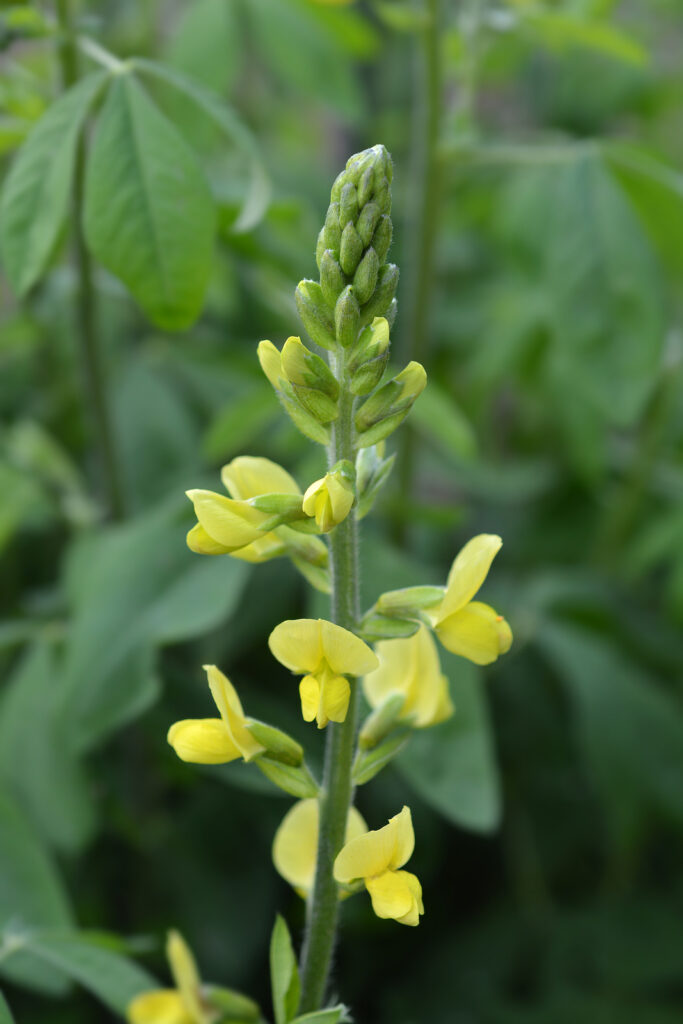Thermopsis–commonly called false lupine–is a rhizomatous perennial cultivated for its attractive foliage and yellow or purple pea-like flowers. From a distance, Thermopsis looks like lupines (Lupinus spp. or baptisia (Baptisia, spp.).
Thermopsis is native grassy mountainsides and woodlands in North America. It can grow in full sun or very light shade and wants well-drained soil that remains evenly moist.
Thermopsis has basal 3-palmate (handlike) leaves with three leaflets. Flowers appear on erect stems. The flowers have rounded petals.
Thermopsis is suitable for a mixed or herbaceous border. Thermopsis’ rhizomes can spread so it is best to divide and replant rhizomes that spread.
Thermopsis is a genus of about 20 species of rhizomatous perennials.

Get to know Thermopsis
- Plant type: Rhizomatous perennials
- Growing zones and range: Zones 3-8
- Hardiness: Hardy to Zone 3
- Height and width: 24 inches (60cm) to 4 feet (1.2m) tall and 24 inches wide
- Foliage: 3-palmate leaves with some silvery and hairy
- Flowers: Pea-like flowers with rounded petals on terminal racemes.
- Flower colors: Yellow or purple
- Bloom time: Late spring and early summer
- Uses: Herbaceous border, wild garden, cottage garden
- Common name: Mountain false lupine, Carolina lupine
- Botanical name: Thermopsis
- Family name: Fabaceae
- Origin: Woodlands in North America, Siberia, Northern Indi
Where to plant Thermopsis
- Grow Thermopsis in a light, well-drained, loamy soil.
- Plant Thermopsisin full sun or partial shade; will tolerate a wide range of conditions.
- Where summers are hot, plant Thermopsis where it can get mid-day shade.
- Thermopsis can be invasive so its best planted in wild garden.
When to plant Thermopsis
- Sow seeds in the garden or set out container-grown plants in spring.
Planting and spacing Thermopsis
- Space Thermopsis 24 inches apart.
How to water and feed Thermopsis
- Water Thermopsis to keep the soil evenly moist.
- Fertilize Thermopsis with an all-purpose fertilizer in spring.
Care Thermopsiscare
- Thermopsis does not like having its roots disturbed.
- Stake plants in early spring to keep the growing erect.
Thermopsis pests and diseases
- Thermopsis can be attacked by slugs, aphids, powdery mildew, and leaf spot.
Thermopsis propagation
- Sow seed at 50°-55°F in spring; transplant seedlings when 4 to 6 inches tall.
- Divide Thermopsis by severing and potting up portions of a clump that spreads too far.
- Divisions are slow to re-establish.
Thermopsis varieties to grow
- Thermopsis rhombifolia, mountain false lupine. Rhizomatous perennial with unbranched stems palmate leaves with broadly ovate leaflets; yellow flowers on erect terminal racemes; grows 36 inches tall and 24 inches wide.
- T. villosa, Carolina lupine. Rhizomatous perennial with few branches; palmate leaves have lance-shaped leafless; downy yellow flowers in late spring; grows 3 to 5 feet tall and 24 inches wide.















